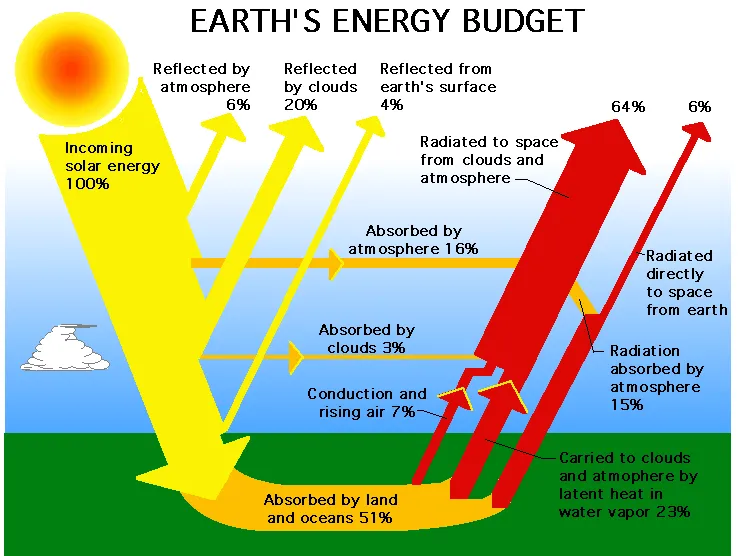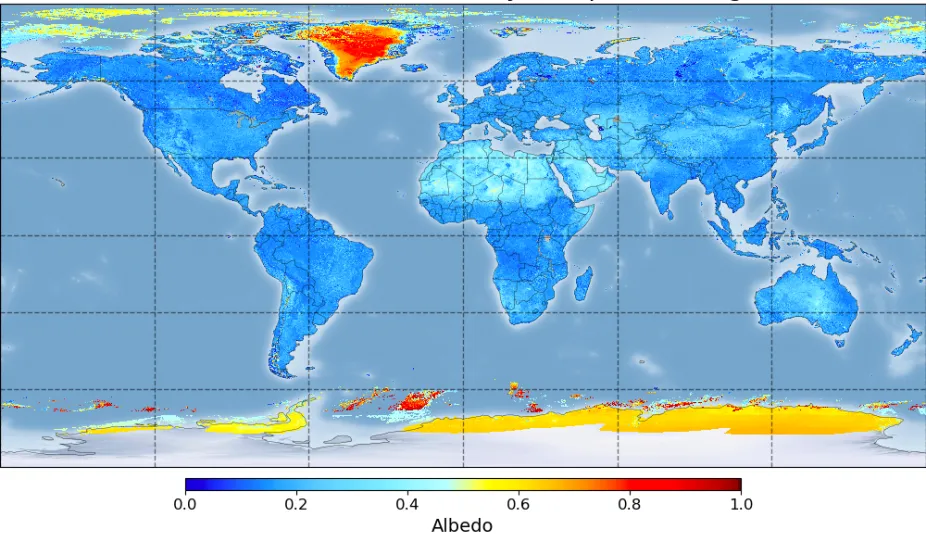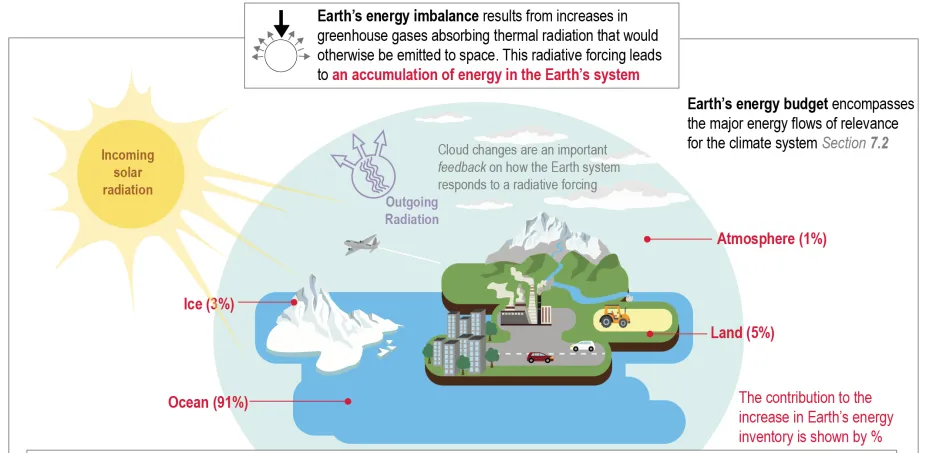The Energy Budget
Earth’s energy budget represents the balance between the amount of energy incoming to Earth from the Sun and the amount of energy outgoing from Earth back to space. The energy budget provides a way to account for all the energy entering and leaving the Earth system.
The diagram below shows how the energy reaching Earth from the Sun is absorbed, reflected, and released by Earth’s atmosphere and surface. The incoming solar energy is measured in watts per square meter (W/m2 or W·m-2). Imagine laying out a one meter by one meter square on the ground or on a wall. Now measure how much solar energy falls on that square each second. That's a watt per square meter. In its orbit around the Sun, the part of Earth that faces the Sun receives approximately 1,371 W/m2 of energy. Averaged over the area of Earth's full sphere, the energy from sunlight coming to the top of the atmosphere is approximately 340 W/m2. [Detailed view of Earth's energy budget]

This diagram of Earth’s energy budget shows incoming energy from the Sun and where that energy goes once it reaches the Earth system.
NASA GPM
Incoming and Outgoing Energy
The majority of energy from the Sun reaches Earth in the form of visible and infrared radiation. Just over half of this incoming solar energy ultimately reaches the ground. The rest is reflected away by low-level, thick, white clouds or ice or gets absorbed by the atmosphere.
The solar energy that makes it to the ground warms Earth’s surface. The warm ground and oceans then release this heat back into the atmosphere in the form of infrared, or thermal, radiation. The amount of infrared radiation emitted from Earth’s ground or oceans depends on temperature: warm surfaces emit more thermal radiation, while cooler surfaces emit less.
Clouds and the gases that make up Earth’s atmosphere absorb much of this infrared energy and emit it as radiation both into space and back down to the planet’s surface. Did you know that Earth’s surface gets almost twice as much radiation from the atmosphere as it does from direct sunshine? That’s because the Sun heats the surface only during the day, while the atmosphere, and any heat it holds, is present all the time.
Earth’s Surface Characteristics and Albedo
Earth’s surface is covered by things like water, soil, rocks, forests, snow, and sand. Different surface characteristics have different ways of affecting the solar energy reaching our planet. Some surfaces are more reflective than others, characterized by the surface’s albedo. Albedo refers to the amount of energy reflected by a surface and is measured on a scale from zero to one (or sometimes as a percent). Dark colored surfaces, like ocean and forests, reflect very little of the solar energy that gets to them, while light colored parts of the planet’s surface, like snow and ice, reflect almost all of the solar energy that reaches them.

The albedo of Earth’s surfaces, from forests and land surfaces (shown by darker blues) to brighter deserts (light blues), and ice and snow (yellows and reds), determines how much incoming energy from the Sun is reflected back to space.
NOAA JPSS
Because much of Earth’s land surface and oceans are dark in color, they absorb a large amount of the solar energy that gets to them, and reflect only a small fraction of it. For instance, forests have a low albedo, near 0.15, and the albedo of the oceans is even lower, about 0.05-0.10. Snow and ice, on the other hand, are very light in color. They reflect most of the solar energy that gets to them, absorbing very little. Their albedo is very high, about 0.80 or 0.90.
The Role of Clouds
Clouds, usually appearing as bright white when seen from space, have a high albedo. Different types of clouds reflect different amounts of solar energy, but overall, clouds reflect a large amount of solar energy out to space. If there were no clouds, Earth’s average albedo would drop by half.
The combined albedo of Earth’s surface (including all surface types) and clouds in the atmosphere is called the planetary albedo. Earth’s planetary albedo is about 0.30 to 0.35. That means that about a third of the solar energy that gets to Earth is reflected back to the atmosphere and space and about two thirds (51% by land and ocean, and 16% by atmosphere) is absorbed. The Moon’s albedo is 0.12, much lower than that of Earth. Despite the Moon appearing bright to us, only about 12% of the sunlight that reaches it is actually reflected.
How the Energy Budget Affects Climate
Earth’s climate depends on the overall balance of incoming and outgoing energy. If Earth’s climate is colder and there is more snow and ice on the planet, more solar radiation is reflected back out to space and the climate will get cooler. On the other hand, when warming causes snow and ice to melt, darker colored Earth surfaces and ocean are exposed and less solar energy is reflected out to space. This process causes even more warming and is known as the ice-albedo feedback loop.

Earth’s energy budget currently has a slight imbalance. Greenhouse gases are preventing a larger amount of infrared radiation from escaping to space, leading to an accumulation of energy and warming of the planet.
IPCC, WG1, 2021
The energy coming to Earth as sunlight almost exactly balances the energy leaving as infrared radiation. If it doesn’t balance, Earth will heat up or cool down. Scientists have found that in recent years, not all of the absorbed energy is offset by energy emitted back into space. The most recent IPCC report reveals that extra energy is being held in Earth’s atmosphere, and the amount of this extra energy is increasing, from just under 0.60 Wm-2 at the end of the last century to 0.79 Wm-2 in 2006-2018. As human activities add more greenhouse gases to the atmosphere, these gases cause even more heating of the planet.